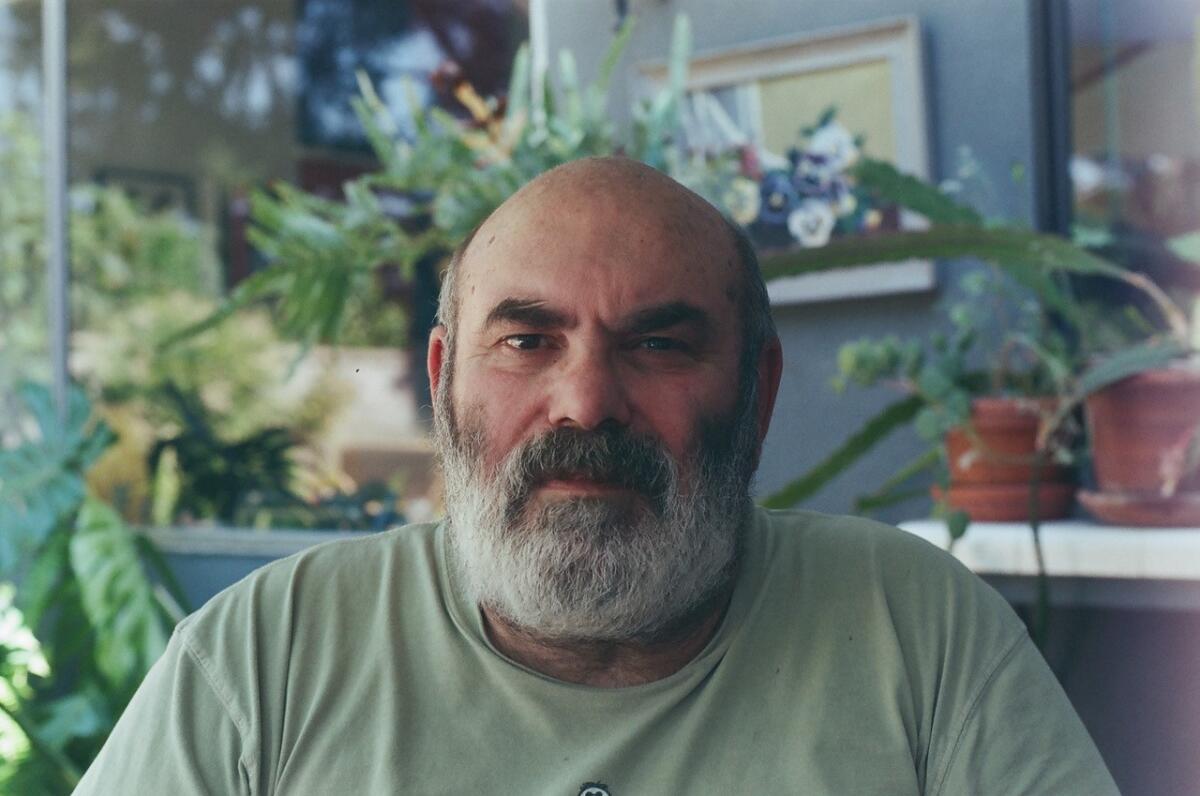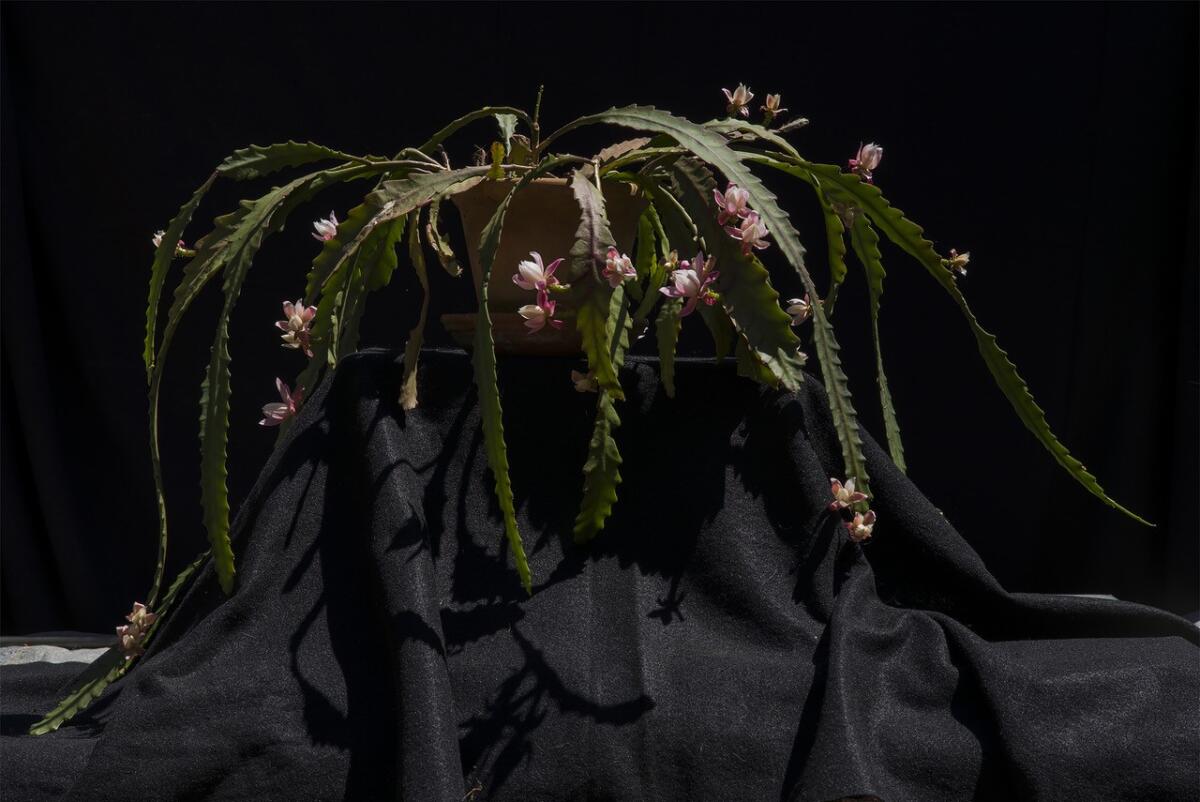Luciano Perna, an L.A. Conceptual artist known for spectral photos and homey sculptures, dies at 63

Luciano Perna, a Conceptual artist whose quirky sculptures and varied photographs play with the elasticity of matter and time, often concealing unexpected autobiographical depths, died Dec. 28 in Los Angeles.
The cause was an apparent heart attack, according to Darcy Huebler, his wife of 35 years and associate dean at California Institute of the Arts in Valencia. He was 63.
Perna was among 90 artists included in “Photography of Invention: American Pictures of the 1980s” organized in 1989 by the Smithsonian American Art Museum in Washington, D.C., to celebrate the 150th anniversary of the invention of the modern camera. His work was featured in exhibitions at Los Angeles Contemporary Exhibitions, the Laguna Art Museum, the List Visual Art Center at MIT, New York’s DIA Art Foundation, the Institute of Contemporary Art in Los Angeles, the ICA in London and other museums and artist-run spaces.
In the early months of the 2020 effort to curb the COVID-19 pandemic through sequestered lockdowns, Perna began to post spare, elegant still-life images on social media. The photographs maximized the digital medium’s capacity as an exhibition space that is at once independent and communal.
The spectral pictures show antique museum artifacts, unraveling balls of string and fragile, flowering succulents and cactuses against velvety, quietly ominous black backgrounds. The objects appear alien and ancient, delicate and determined. The photographs were featured the following fall in Artforum magazine, where critic Benjamin H.D. Buchloh described them as “blossoms of current confinement and despair.” Inkjet prints were displayed last year in Paris at Marian Goodman Librarie.

Born in Naples, Italy, on Jan. 14, 1958, to Elena Chiesa and Berardo Perna, he began to take photographs at 14, inspired by his father’s amateur work with a now-classic Leica M3 camera. Young Perna learned to develop and print his pictures in a home darkroom.
After the death of both parents within months of each other when he was not yet 16, he moved to Caracas, Venezuela, to live with an older half-brother, Claudio Perna, a Conceptual artist and geographer. He stayed for five years.
While briefly employed at the National Library of Venezuela, he did archival work, which included providing documentation of the presidential election campaign of Carlos Andrés Pérez. He also found work in a local commercial portrait studio. Throughout his career, Perna recorded international artists in photographic portraits, some casual and others inspired by the Dada and Surrealist camera work of Man Ray.
Claudio, who died in 1997, introduced Luciano to the adventurous countercultural curriculum he had read about at CalArts. Perna took the leap, enrolling at the American school in 1979. The archival and portrait threads first explored in Caracas came together in L.A., where he later worked as a studio technician for Ray Eames on production of the 1989 Abrams book “Eames Design: Work of the Office of Charles and Ray Eames.”
At CalArts Perna found a sympathetic faculty cohort, including such Conceptual art stalwarts as John Baldessari, Douglas Huebler (whose daughter he would marry) and Barbara Kruger, and photographers Judy Fiskin and Jo Ann Callis. He embraced lessons gleaned from the feminist art movement, which had carved out a central place in the school’s wide-ranging curriculum. He earned a BFA in 1984 and an MFA in 1986, both in photography.
The late-1960s Italian Arte Povera movement, which had set aside traditional art materials like paint, canvas, carved stone and cast metal in favor of humble, everyday provisions often found around the house, was instrumental in shaping Perna’s emerging aesthetic. Typical was an edition of small flashlight sculptures, a subject that recalled precedents by Jasper Johns and Claes Oldenburg but took a very different form.
Rather than casting the object in bronze or building a towering monument from industrial steel, as the American Pop artists had done, he cobbled the objects together from ordinary domestic items: kitchen drain plungers, light bulbs, duct-taped batteries and an on-off switch made from clothespins. The fully functional result was also a witty, unpretentious tool helpful in conceptually unclogging blockages of conventional thought needing to be flushed down the drain.
In other examples, a plate of spaghetti upended on a canvas could signify the satisfying consumption of tangled linear skeins of color in a Jackson Pollock drip painting. For a sculpture titled “Arte Povera,” a black wheelbarrow piled with chunky rocks painted gold both consecrated and commemorated manual labor in an age of post-industrial transformation.
Perna was as likely to fashion a lifesize sculpture of a motorcycle or a race car, ostensibly masculine subjects, from kitchen pots and pans, dart boards, record albums and backyard barbecue grills as from the vehicles’ more familiar component parts easily gathered up at an ordinary automotive shop. A playful, homey, do-it-yourself ethos was amplified.
His motorcycle was based on a movie image — the so-called “Captain America chopper” ridden by Peter Fonda in “Easy Rider,” the 1969 end-of-an-era cult classic. The iconic motorcycle with an American flag gas tank was celebrated in a poster that adorned the bedroom of Perna’s youth in Naples. His fabricated version featured the famous handlebar fork, extended more than a foot beyond a normal Harley-Davidson length and made from a pair of hospital crutches. The visual rhyme conjured a culture of injury.
“I didn’t see the movie,” the artist told critic David Pagel in a 1993 Bomb magazine interview, “it wasn’t accessible to me. I just saw the pictures, and I imagined what was in the film.”
The capacity for photographs to ignite imagination rather than merely index reality fueled much of Perna’s work. Humility essential to an Arte Povera aesthetic brought any flights of utopian fantasy down to earth. Fertile cultural terrain was provided by a life lived in Naples, Caracas and Los Angeles — grand international cities also grounded in fallen Spanish colonial empires.
The layered fictions of Hollywood movies provided thematic grist for a 1999 solo exhibition at the Santa Monica Museum of Art. Included was a cherry-red Ducati motorcycle, its hyper-futuristic, streamlined design a glamorous surprise tucked behind a wide horizontal plinth, painted flat black. The plinth, echoing the mysterious monolith in Stanley Kubrick’s “2001: A Space Odyssey” but here notably toppled on its side, rested atop a wheeled dolly. The ensemble awaited removal for the next contrived scene in an imagined film.
The art museum exhibition, titled “Science/Fiction: A Movie Studio Set,” was framed as a homemade soundstage. In an Arte Povera twist, scores of ordinary purple egg cartons stapled to the back wall provided a “futuristic” spaceship interior, suitable for daydreams arising from a kid’s playroom. With the camera as an industrial emblem for the visual history of Modernist art, Perna set his work against a common urge to fabricate idealized visions.
One major art city celebrates another as the Pompidou Center goes West Coast.
Fahey Klein Gallery presented Perna’s first commercial solo exhibition of photographs in 1988. At Thomas Solomon’s Garage a year later, Perna showed geometric abstract paintings constructed from plastic sheeting into which metal weights were hidden; each work was priced by the pound.
Perna poked a wickedly droll finger in the eye of an unprecedented 1980s art-market boom, which was setting records and garnering headlines. The weightier the painting, the higher the price tag.
Solo shows followed at Rosamund Felsen Gallery, also in L.A., Holly Solomon Gallery in New York, Dennis Anderson Gallery in Antwerp, Belgium, Tanja Grunert Gallery in Cologne, Germany, and numerous others. He was included in more than 50 group shows in the United States and Europe. His work is held in the Los Angeles County Museum of Art; the Walker Art Center, Minneapolis; the Museum of Fine Arts, La Chaux-des-Fonds, Switzerland; and numerous private collections.
Ten photographs of emerging and established artists associated with CalArts as the Los Angeles art scene emerged into international prominence in the early 1980s — including Michael Asher, Jonathan Borofsky, Lari Pittman, Stephen Prina, David Salle and several others — illustrated the catalog to the major 2006 survey exhibition “Los Angeles 1955-1985: Birth of an Art Capital” organized by Paris’ Centre Pompidou.
Memorial plans for Perna are pending.
More to Read
The biggest entertainment stories
Get our big stories about Hollywood, film, television, music, arts, culture and more right in your inbox as soon as they publish.
You may occasionally receive promotional content from the Los Angeles Times.











